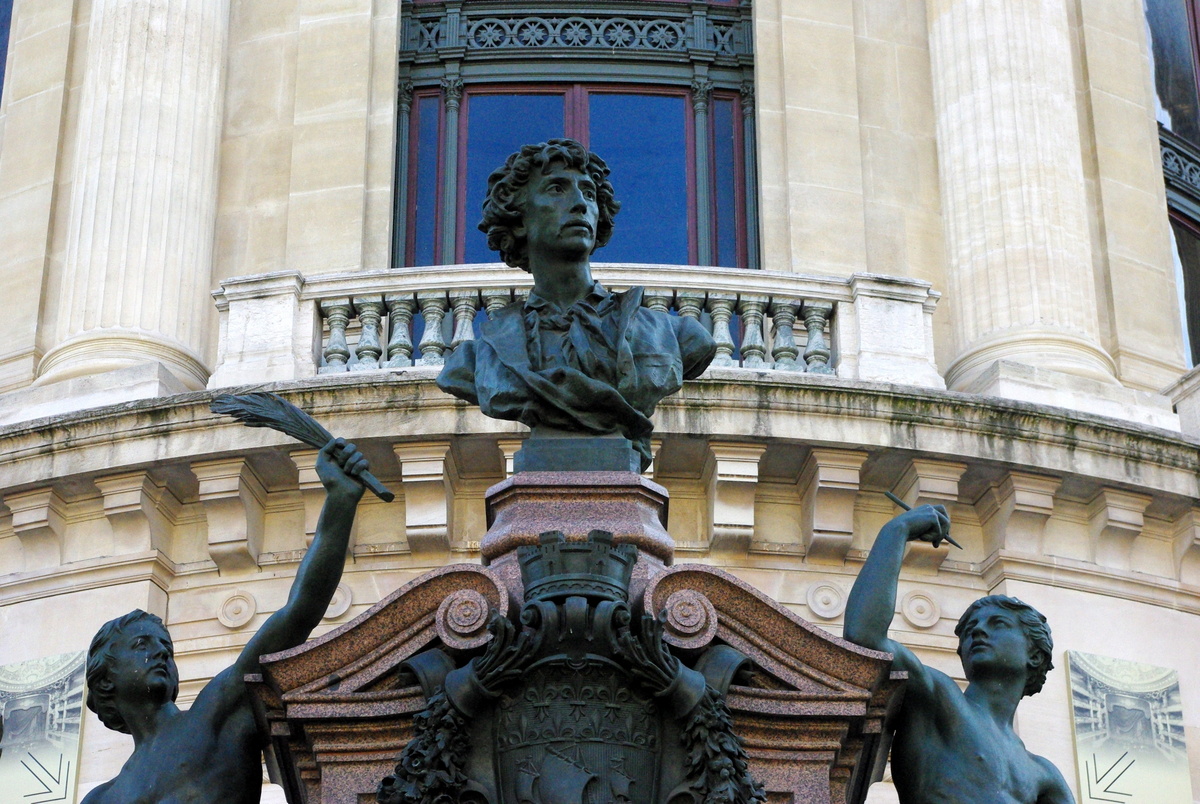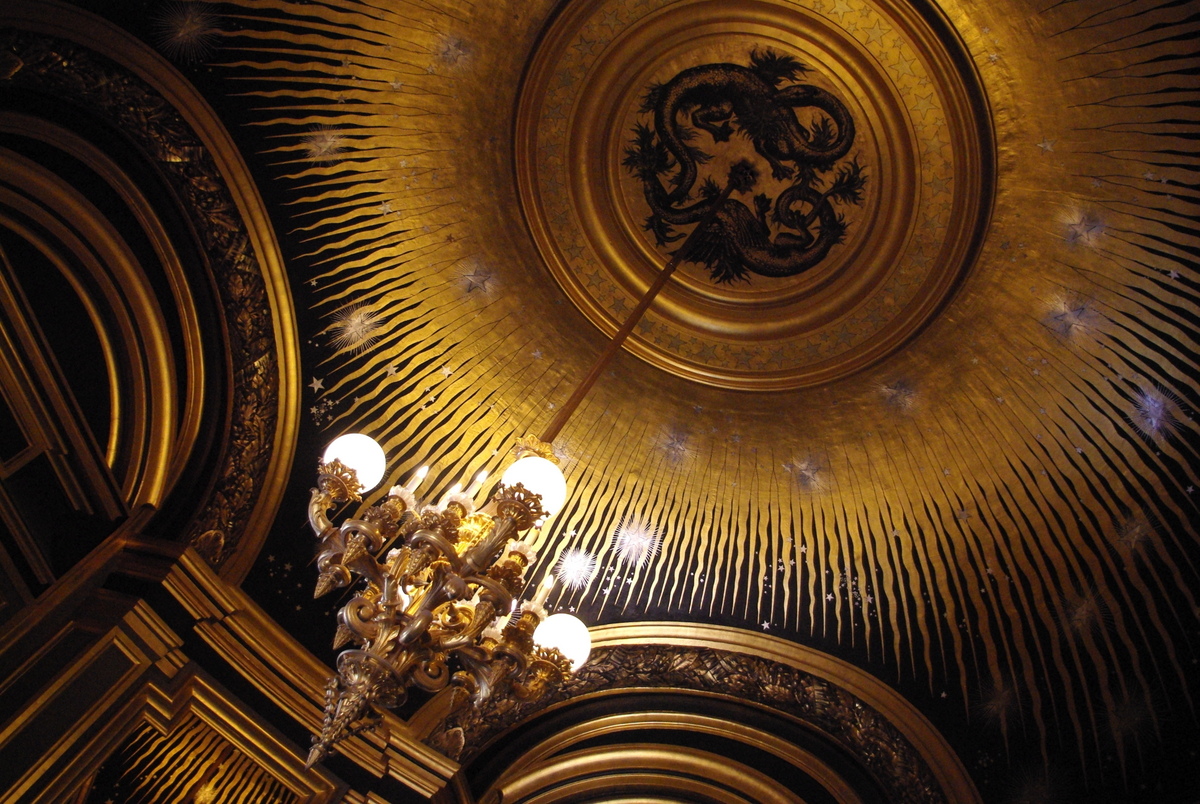The Opera Garnier or Palais Garnier is one of Paris’ most celebrated monuments. Situated in the 9th arrondissement at the end of the Avenue de l’Opéra, the sumptuous opera house symbolises the opulence of the Second Empire.
Palais Garnier: a bit of History
Prior to the opening of the Palais Garnier, the home of the Paris Opera was on the rue Le Peletier. Designed by architect François Debret it served as a theatre from 1821 to 1873.
Napoleon III’s assassination attempt
On the 14th of January 1858, Napoleon III (1808-1873) survived an assassination attempt by Orsini in the rue Le Peletier on his way to the theatre. The Orsini Affair led the Emperor to build a new opera house with a separate and more secure entrance for him.

Charles Garnier, winner of the contest
A contest in which 171 applicants (including Viollet-le-Duc and Rohault de Fleury) competed was launched. The winner was Charles Garnier (1825-1898), a young French architect still unknown at the time and who had not built such a grand edifice. The edification of a new opera house on a site imposed by Baron Haussmann.

Construction started in 1861 with the laying of the first stone by the Emperor in 1862. Built on a site suggested by Baron Haussmann, the Opera House required almost 15 years for its completion, from 1861 to 1875.

A Napoleon III style Opera House
The new opera house was the prototype and synthesis of the Second Empire style also known in French as ’Style Napoléon III’. Charles Garnier invented a new style which puzzled many of his contemporaries, including Empress Eugenie who once asked Garnier:
“What is this style? This is no style, it is not Greek or Louis XVI“, the architect answered: “No Ma’am, those styles are all outdated, this is Napoleon III“. Indeed the architectural style of the Second Empire can be seen as lacking unity with an eclectic mix of earlier European styles including baroque curves and ornamental profusion.
The first inauguration took place on the 15th of August 1867 and related only to the completed façade.
The laying out of Avenue de l’Opéra
No sooner was the façade unveiled that the emperor required from Baron Haussmann the construction of a new axis linking the opera to his residence, the Tuileries Palace. Called ‘avenue de l’Opéra’, it put a spectacular emphasis on the opera house. Architect Garnier fought against Haussmann about the plantation of trees on the street. For Garnier, the opera house had to stay the main focus of the great perspective where leaves and branches would have hindered the grand view. This explains why the avenue de l’Opéra is the only street of Haussmann’s ‘Grands Boulevards’ without trees.



The completion of Palais Garnier
Construction was paused during the 1870-71 Franco-Prussian war when the inside of the opera house was turned into a warehouse. The war led to the fall of the empire. Napoleon III went into exile in England and the Third Republic was proclaimed.
When the old opera of rue Le Peletier burnt down on the 28th of October 1873, the government decided to complete the edifice and called back Charles Garnier.
The inauguration of the whole complex took place on the 5th of January 1875 in the presence of the President of the French Republic, Marshal MacMahon, the Lord Mayor of London, the Lord Mayor of Amsterdam, King Alfonso XII of Spain, and nearly 2,000 guests from all over Europe.
In 1887 electric lighting replaced gas inside the opera house.
Paris’ Two Opera Houses!
The whole opera house was listed as a ‘Monument Historique’ by the French State in 1923. The Palais Garnier underwent a series of restoration work in the 2000s and 2010s.
With the opening of the Opera Bastille in 1989, the Palais Garnier lost its status as the primary home of the Paris Opera. It is mainly used for ballet performances.
The Palais Garnier was a famous set for the movie ‘La Grande Vadrouille’ (Don’t look now, we’re being shot at) starring Louis de Funès in 1966.
Buy your online tickets to visit the Opéra House of Paris:
Let’s have a look at the Exterior of Palais Garnier
“I consider the building’s façade the most typical and most personal part of the whole work, and even if it had more flaws than it already does, I would still be proud of designing it. True, there is some regrettable heaviness, but also perfect elegance. If I had done only the first-storey loggia and used marbles of various colours, I believe I would have largely fulfilled my duty as artist, while making some mistakes, truth be told; but in going off the beaten track and boldly moving forward!” Charles Garnier

The Palais Garnier is 173 m long by 125 m wide and covers an area of 11,237m2.
The statue of Apollo playing the lyre is the highest point of the building and stands 73.60 m above ground level.
The façade overlooks the place de l’Opéra with a series of sculpted figures, friezes, mosaics and columns designed by 14 painters and mosaicists and 73 sculptors.
Access to the inside of the Opera House is through the ground floor pierced by seven arcades.
The façade revealed!
The ground floor is surmounted by the loggia with 8 double columns in stone which are connected by 7 balconies flanked by 18 marble columns. Each balcony is topped by gilded bronze busts of great composers (from left to right): Rossini, Auber, Beethoven, Mozart, Spontini, Meyerbeer, and Halévy.
The entablature of the coupled columns above the loggia features the words ‘ACADÉMIE NATIONALE DE MUSIQUE’.
Above the entablature is a frieze which features decorative bas-relief medallions ’N’ for Emperor Napoleon III and high-relief medallions ‘E’ for Empress Eugenie or Emperor. They were removed after the fall of the empire in 1871 but restored in the 2000s.

The left and right extremities of the façade are topped by two gilded figural groups by Charles Gumery: Harmony (L’Harmonie) and Poetry (La Poésie).


The green cupola sits above the auditorium.
The triangular pediment which rises up behind the cupola marks the front of the stage. It is crowned by a sculptural group ‘Apollo, Poetry, and Music’ by Aimé Millet. It depicts Apollo playing the lyre. Two bronze Pegasus figures by Eugène-Louis Lequesne stand at either end of the south gable.

Let’s explore the Interior of the Opera House
The interior of Palais Garnier is designed for sumptuous occasions. Characteristic of Baroque opulence it features multicoloured marbles quarried in different parts of Europe, gold leaf and a plethora of sculpted figures.
The Grand Vestibule

The Grand Vestibule contains the statues of four composers: Rameau, Lulli, Gluck and Haendel.
The Rotonde des Abonnés

The Rotonde des Abonnés on the ground floor is a circular vestibule that once served the subscribers who accessed the opera through the east side (Place J. Rouché). The ticket office for visits is located next to the rotunda.
The Pythia Basin

The ‘Bassin de la Pythie’ is situated under the Grand Staircase. The Pythia was a priestess of the Temple of Apollo at Delphi on the slopes of Mount Parnassus.
The Grand Staircase

The ceremonial Grand Staircase (‘Grand Escalier‘) of white marble with a balustrade of red and green marble leads to the Grand Foyer and to the various levels of the auditorium. The double staircase was inspired by that of Bordeaux Theatre.

At the bottom of the staircase, visitors are welcomed by two female allegories (‘Les Torchères‘) holding bouquets of light.
The ceiling of the staircase’s nave was painted by Isidore Pils and depicts scenes of The Triumph of Apollo, The Enchantment of Music Deploying its Charms, Minerva Fighting Brutality Watched by the Gods of Olympus, and The City of Paris Receiving the Plan of the New Opéra.

The Avant-Foyer

Before entering the Grand Foyer, the Avant-Foyer offers a great view of the Grand Staircase’s nave. Its ceiling is decorated with mosaics with shimmering colours on a gold background.
The Grand Foyer

The architectural magnificence of the Grand Foyer with its domed ceiling covered with mosaics is reminiscent of the Hall of Mirrors in Versailles with a play of mirrors and windows. The hall is 154 m long, 13 m wide and 18 m high. The ceiling is covered by paintings from Paul Baudry as a homage to the history of music. The lyre is omnipresent and can be seen in the capitals, the heating grates and the door nobs. A bust of Charles Garnier has been placed in the centre of the foyer overlooking the avenue de l’Opéra.




The Loggia

The Loggia offers a view of the majestic perspective of the avenue de l’Opéra all the way to the Louvre. Its ceiling is decorated with five mosaic roundels of smiling or moody grotesque masks.

The Salon de la Lune and Salon du Soleil

At both ends of the Avant Foyer. the two small halls offer a symbolic and poetic transition to the western and eastern sides of the Opera House.
The Galerie du Glacier

The hallway with its chandeliers links the Avant-Foyer to the Salon du Glacier.
The Rotonde du Glacier

At the end of the Galerie du Glacier, the light rotunda was completed after the opening of the Palais Garnier in 1875. The decoration is therefore typical of the Belle Époque: tapestries illustrating drinks as well as hunting and fishing scenes, paintings in the ceiling by Georges Jules-Victor Clairin (1843-1919) with bacchantes and fauns.
The Auditorium

The Italian horseshoe-shaped auditorium is sumptuously decorated with red velvet, stucco, marble and gold leaf. The five-tiered auditorium sits 2,013 and is 60 metres high from floor to ceiling.

The decoration contrasts with the ceiling painted by Marc Chagall in 1964.
The giant bronze and crystal chandelier designed by Charles Garnier consists of 340 lights.


The Opera Museum

In the Emperor’s Pavilion (West side of the building), a permanent exhibition displays three-dimensional models of stage sets, photographs, drawings and paintings.
The museum also houses an interesting library containing 600,000 documents on theatre, dance and music, including 100,000 books, 1,680 periodicals, 16,000 partitions, 100,000 photographs, 30,000 sketches, and 3,000 administrative archives.
Panoramic Views of Palais Garnier
Palais Garnier viewed from the South Tower of Notre-Dame Cathedral:

Palais Garnier viewed from the Montparnasse Tower:

More panoramic views of Palais Garnier from various sites in Paris.
More info…
Buy your online tickets to visit the Opéra House of Paris:
For more info about shows and concerts, check out the official website of the Opéra de Paris.



